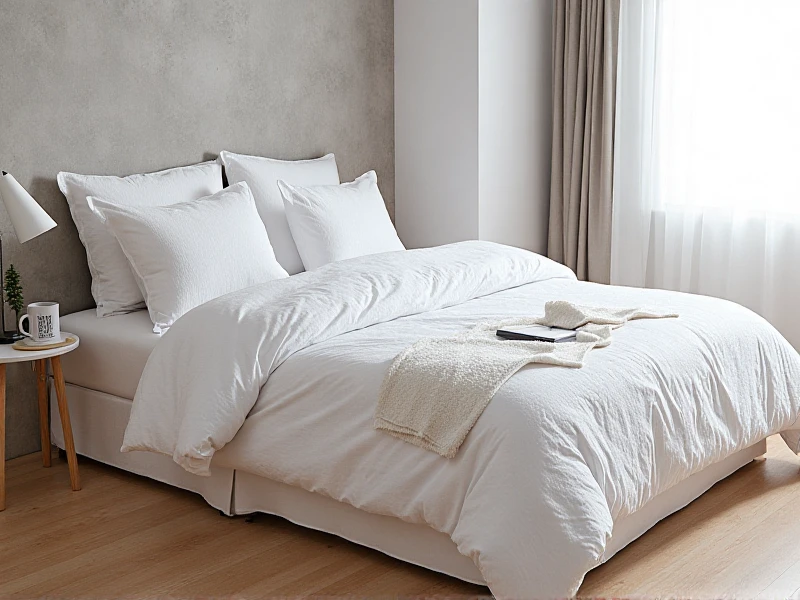The Unsung Hero of Better Sleep & Beauty: Why Your Pillowcase Matters More Than You Think
2025-06-01

Here is an SEO-optimized article about pillowcases:
That crumpled rectangle of fabric you rest your head on every night? Don't underestimate its power. Pillowcases are far more than just decorative accents; they're the silent players influencing your sleep quality, skin health, hair texture, and bedroom hygiene. Choosing the right one isn't just an aesthetic decision—it's a commitment to your well-being.
The Impact on Skin & Hair
Your face makes intimate, prolonged contact with your pillowcase for 6-8 hours nightly. The fabric type matters immensely:
Friction & Creases: Coarse cotton or poly-blend pillowcases create friction. This constant rubbing can lead to premature wrinkles ("sleep lines"), exacerbate skin irritation (especially sensitive or acne-prone skin), and roughen facial skin. Satin and silk pillowcases dramatically reduce friction, letting your skin glide smoothly.
Oil & Grime Absorption: Pillowcases absorb natural oils, sweat, skincare residue, and environmental dirt nightly. Without proper care, this creates a breeding ground for bacteria and allergens. Low-quality pillows and pillowcases become a magnet for dust mites.
Hair Health: Cotton pillowcases notoriously cause tangling and frizz, especially for curly or textured hair. They absorb your hair's natural oils, leaving it dry. Conversely, smooth silk or satin pillowcases reduce friction, helping prevent breakage, split ends, and bedhead, and locking in moisture for healthier-looking locks.
Material Matters: Finding Your Perfect Pillowcase
The material is the cornerstone of your pillowcase experience. Key contenders are:
1. Cotton (Especially Long-Staple Egyptian or Pima): Breathable, soft, and naturally absorbent. Great for temperature regulation and comes in various luxurious weaves (percale, sateen, jersey). Ideal for hot sleepers or those seeking classic comfort. Downside: Can wrinkle easily and causes friction.
2. Linen: Exceptionally durable and highly breathable, wicking moisture away efficiently. Perfect for hot climates and sensitive skin. It softens beautifully with washes but has a distinctly rustic texture. Naturally resistant to dust mites.
3. Silk (Especially Mulberry Silk, Grade 6A): The gold standard for smoothness and low friction. Gentle on skin and hair, naturally hypoallergenic, and helps regulate temperature (cool in summer, warm in winter). Reduces sleep creases and hair frizz/breakage. Requires delicate care. While an investment, silk pillowcases often look and feel truly luxurious.
4. Satin (Often Polyester or Bamboo-Derived Rayon): Offers a silky-smooth feel at a lower cost than silk. Provides significant friction reduction for skin and hair care. Bamboo-derived rayon satin is highly breathable and moisture-wicking. It drapes beautifully but note: True silk satin differs from polyester satin.
5. Bamboo Viscose/Rayon: Eco-friendly, incredibly soft, breathable, and moisture-wicking. Naturally antimicrobial and excellent for temperature control. A popular allergy-friendly choice offering a smooth feel akin to silk.
Beyond Fabric: Key Features to Consider
Weave: Percale is cool and crisp, sateen is silky smooth, jersey is soft and stretchy.
Thread Count Myth: Don't get fooled. A higher thread count (300-400 ) made from quality long-staple cotton or linen signifies potential durability and softness, but beyond 600, it often becomes marketing fluff and can trap heat. Quality of fiber is more crucial.
Closure: Envelop closures are secure and neat. Button closures are traditional. Zippers offer ultimate security but can scratch. Hidden zippers are excellent.
Size & Fit: Ensure it perfectly fits your pillow – standard, queen, or king. A snug fit prevents bunching but leaves room for the pillow to fluff.
Hypoallergenic: Essential for allergy sufferers. Look for tightly woven fabrics like silk, dust-mite-resistant synthetics, or certified hypoallergenic materials.
Caring for Your Pillowcases: Protect Your Investment
Wash Frequency: Wash pillowcases at least weekly to remove sweat, oils, and dead skin cells. Twice a week is better for acne-prone skin.
Gentle Cycle: Use cool or warm water and a mild detergent. Avoid harsh chemicals and bleach.
Dry Low: Tumble dry silk/satin on low or hang/lay flat. Hot drying damages fibers and elastic and causes wrinkles.
Avoid Fabric Softener: It coats fibers, reducing breathability and absorbency (especially bad for towels!). Use white vinegar occasionally for natural softening.
Iron Carefully: If needed, iron according to the fabric's care label. Silk/satin on low heat inside out.
The Comfort & Aesthetics Factor
Let's not forget the basics: softness against your cheek and appearance. Pillowcases define your bed's look. Coordinate with your sheets or make a statement with patterns and colors. Feeling soft, cool fabric promotes relaxation, making that pillow feel even more inviting at the end of a long day.
Conclusion: Choose Wisely, Sleep & Shine Better
Your pillowcase is a crucial yet often overlooked element of your sleep sanctuary and self-care routine. Whether your priority is anti-aging, reducing acne, battling frizz, regulating temperature, or simply feeling luxurious comfort, selecting the right material and style makes all the difference. Ditch the scratchy, neglected fabric. Invest in the best pillowcases you can. Look for high-quality cotton, breathable linen, calming bamboo, or luxurious silk/satin. Prioritize gentle hygiene. The result? Waking up feeling more refreshed with smoother skin, happier hair, and the confidence that comes from choosing wisely for your health and comfort. Isn't that worth swapping out that old pillowcase? Explore the options – your skin, hair, and sleep will thank you.
Category: